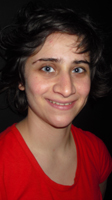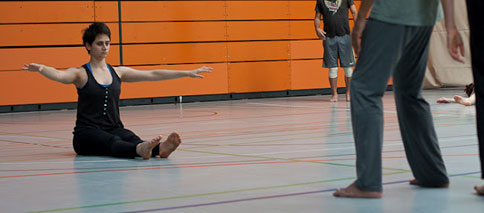
 |
Thalia studied dance at the University of Cape Town. She has performed with the First Physical Theatre Company and Underground Dance Theatre, and has trained in contemporary dance, ballet, yoga, contact improvisation and butoh. She is currently working towards completing her Masters in Choreography at Rhodes University in South Africa. My niece and nephew are CI experts. Together they jump, laugh and roll across the floor. They have no preconceptions of the ‘proper’ way to dance and play. Their movement stays close to the ground and there is no self consciousness interrupting their game. They follow enjoyable sensations and images as we sit on the couch to watch them. We all start dancing in this way. Understanding our world through sensation and movement. But as we grow up this way of learning is packed away and often suppressed. |
As a child I was sent to dance class to remedy my posture. I began to enjoy the classes and started taking the discipline seriously, until eventually the technical demands of the form began causing injury and distress.
My body is resisting this technique…. I need to move slower. I need more time. I want to feel what is happening, to experience, to figure it out. I am involved in an enquiry and I will only move in a way that feels natural and functional. I want to move with ease. Without tension or pain. I want to feel fluid, continuous and soft.
On the path to recovery, I began to understand a body integrity that said ‘yes I want to dance, but not like that’. I found my way to movement practices grounded on somatic principles (contact improvisation, release technique, Authentic Movement) - ways of moving and understanding the body that support what Jill Green refers to as a ‘somatic authority’ (Green271).
![]()
Eyes Open/Eyes Closed Listening
The term ‘listening’ is often used when talking about improvisation to evoke an open and receptive state of paying attention. ‘Listening’ is not limited to hearing with the ears, but includes all the faculties of sensation by which we perceive our internal and external environment. In contact work ‘listening’ is most frequently done through the skin and viscera. We pay attention to the tactile and kinaesthetic information that we receive through ‘listening’ to our bodies in relation to the surfaces they come into contact with. This sensory information is not however limited to touch. The ears and eyes are also part of the moving body, and focus on what we hear and see in contact improvisation is an area in which we can explore further. We can differentiate the kinds of information that we give and receive through working with eyes closed, or we can use our vision and all its possibilities to guide our movement and inform our choices. This is our starting point for spontaneous performance. We can begin to enter the live, listening with our eyes and feeling with our ears.
Some writings from Thalia as pdf
- Some thoughts on moving, training, contact improvisation and performing
- Listening as Performance in Eyes closed with chair and radio

More writings about her score during the research week
and her writing during the week postfestival week